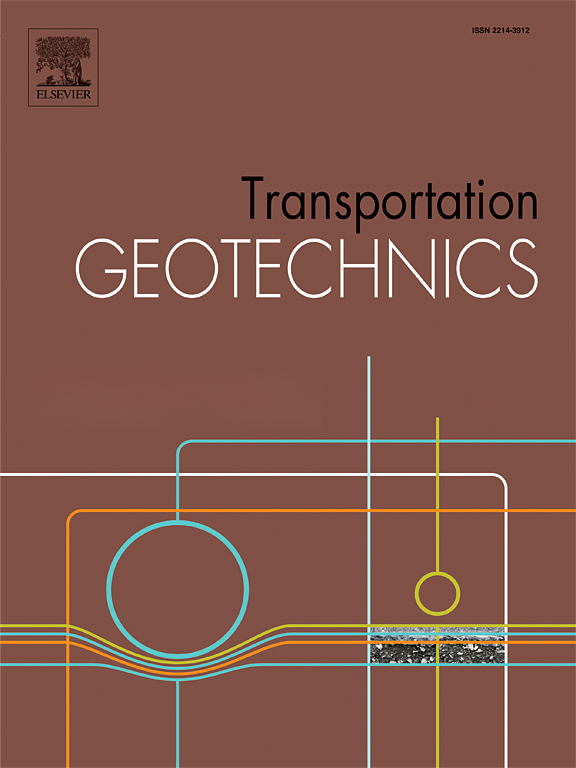Prediction of rail ballast breakage using a hybrid ML methodology
IF 5.5
2区 工程技术
Q1 ENGINEERING, CIVIL
引用次数: 0
Abstract
Particle breakage is a key performance indicator to estimate ballast degradation as it severely affects the performance and maintenance of rail tracks. Most constitutive models usually based on continuum mechanics have rarely been able to estimate the rate and intensity of particle degradation under repeated wheel loading. In this regard, this paper presents a novel model for predicting ballast breakage under prolonged cyclic loading using artificial neural networks (ANN) coupled with a genetic algorithm (GA), hence the acronym GA-ANN. For this study, a comprehensive database consisting of 130 experimental datasets on ballast breakage under cyclic loading conditions is used. Unlike most black-box type machine learning (ML) models, this study incorporates a knowledge-guided selection of 9 input parameters encompassing gradation characteristics, particle angularity, the initial physical state of the granular assembly, and the applied stress state. To overcome limitations associated with potential overfitting when using smaller datasets of the Ballast Breakage Index (BBI), this study employs an innovative approach by integrating k-fold cross-validation and regularization with conventional GA-ANN algorithm. The proposed GA-ANN model showed superior performance in predicting BBI at different loading cycles and proved to be 50% more efficient when compared to conventional ANN and other ML techniques. When verified against unseen laboratory and field data, the GA-ANN model yielded an between 0.85 and 0.95, thus proving its broader capability. Further, global sensitivity analysis is performed to identify the most significant parameters (cyclic deviatoric stress, number of load cycles and frequency) which warrant more attention during maintenance.
使用混合ML方法预测轨道道砟破碎
颗粒破碎严重影响轨道的使用和维护,是评估道砟退化的关键性能指标。大多数基于连续介质力学的本构模型很少能够估计车轮反复加载下颗粒退化的速率和强度。在这方面,本文提出了一种利用人工神经网络(ANN)和遗传算法(GA)相结合的预测长周期载荷下压载物破碎的新模型,因此简称GA-ANN。本研究使用了一个包含130个循环加载条件下压载物破碎实验数据集的综合数据库。与大多数黑箱型机器学习(ML)模型不同,本研究采用了知识引导的9个输入参数选择,包括梯度特征、颗粒角度、颗粒组合的初始物理状态和施加应力状态。为了克服在使用较小的压载物破碎指数(BBI)数据集时潜在的过拟合的局限性,本研究采用了一种创新的方法,将k-fold交叉验证和正则化与传统的GA-ANN算法相结合。所提出的GA-ANN模型在预测不同加载周期下的BBI方面表现出优异的性能,与传统的ANN和其他ML技术相比,效率提高了50%。当与未见过的实验室和现场数据进行验证时,GA-ANN模型的R2在0.85到0.95之间,从而证明了其更广泛的能力。此外,还进行了全局敏感性分析,以确定在维护过程中需要更多关注的最重要参数(循环偏应力,负载循环次数和频率)。
本文章由计算机程序翻译,如有差异,请以英文原文为准。
求助全文
约1分钟内获得全文
求助全文
来源期刊

Transportation Geotechnics
Social Sciences-Transportation
CiteScore
8.10
自引率
11.30%
发文量
194
审稿时长
51 days
期刊介绍:
Transportation Geotechnics is a journal dedicated to publishing high-quality, theoretical, and applied papers that cover all facets of geotechnics for transportation infrastructure such as roads, highways, railways, underground railways, airfields, and waterways. The journal places a special emphasis on case studies that present original work relevant to the sustainable construction of transportation infrastructure. The scope of topics it addresses includes the geotechnical properties of geomaterials for sustainable and rational design and construction, the behavior of compacted and stabilized geomaterials, the use of geosynthetics and reinforcement in constructed layers and interlayers, ground improvement and slope stability for transportation infrastructures, compaction technology and management, maintenance technology, the impact of climate, embankments for highways and high-speed trains, transition zones, dredging, underwater geotechnics for infrastructure purposes, and the modeling of multi-layered structures and supporting ground under dynamic and repeated loads.
 求助内容:
求助内容: 应助结果提醒方式:
应助结果提醒方式:


